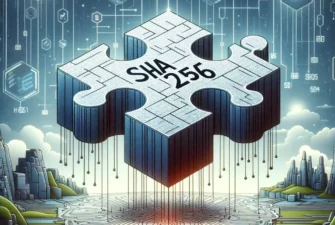
Learning about Secure Hash Algorithms (SHA) for the first time can feel like deciphering an alien code. In reality, it’s not as complicated as it seems. You’ve probably heard of SHA-1, SHA-2, SHA-256, and SHA-512, but do you understand their differences and how they affect your data security?
These cryptographic hash functions play a vital role in data integrity and authentication. However, they’re not created equal. Some offer better security, while others are faster.
This blog covers SHA-1 vs SHA-256 algorithms and everything in between. Let’s dive into the core components of web security and see how they work.
Table of Contents
What Is SHA?
SHA is an acronym for Secure Hash Algorithm, a family of cryptographic hash functions designed by the National Security Agency (NSA). This cryptographic hash function plays a critical role in ensuring the integrity and security of digital data.
The purpose of SHA is to create a unique identifier, called a hash, for any piece of digital information. This hash is like a digital fingerprint, ensuring that even a slight change in the original information results in a completely different hash.
A classic example is your passwords. When you create an account on a website, the site doesn’t store your password. Instead, it uses SHA to convert your password into a hash. The hash resides in the database. So, even if someone gains access to the database, they won’t see your actual password but rather its hashed form.
Let’s say your email password is “likeflowers.” Here’s how it would look hashed:
9a96c8326d228471d1f01616d92a2d2b0e796c9a8d0624df9a9b7d0246475a42
This long string of characters is the SHA-256 hash of your password. If you were to tweak even one letter in your password, the resulting hash would be completely different.
How Does SHA Work?
SHA operates on a principle known as the avalanche effect, where even the tiniest alteration in the information leads to a significant and unpredictable change in the hash. This property makes it virtually impossible for two different outputs to produce the same hash.
Designed to withstand various cryptographic attacks, SHA prevents collision attacks where two different outputs generate the same hash. This robustness is essential for applications like digital signatures, SSL certificates, and verifying the authenticity of data.
There are different versions of SHA, like SHA-1, SHA-256, and SHA-512, each producing hash values of different lengths and possessing distinct security characteristics. Let’s examine them more closely.
Different Versions of SHA
The development of different SHA versions stems from the cryptographic community’s continuous efforts to stay ahead of arising threats. As technology advances and new vulnerabilities emerge, enhancing hash functions becomes essential to maintain the security of digital systems.
Each version aims to address shortcomings identified in its predecessors and adapt to the changing cryptographic requirements. If you want to know the difference between SHA-1 and SHA-256, for instance, understanding what each SHA version does is a starting point.
What Is SHA-1?
SHA-1 is known for its speed but less for its security. Designed by the NSA and published by the National Institute of Standards and Technology (NIST). It produces a 160-bit (20-byte) hash value typically rendered as a 40-digit hexadecimal number.
Because it computes hashes quickly, it’s more susceptible to brute-force attacks, where an attacker tries every possible input to find a match. Over time, vulnerabilities discovered in SHA-1 made it susceptible to collision attacks, where different inputs could produce the same hash.
SHA-1 has been used in digital signatures and SSL certificates. However, due to its weaknesses, it’s deprecated in favor of more secure hash functions like those in the SHA-2 family.
What Is SHA-2?
The SHA-2 family includes hash functions with different output lengths, such as SHA-224, SHA-256, SHA-384, SHA-512, SHA-512/224, and SHA-512/256. The number in the name corresponds to the bit’s lengths of the hash output.
Like its predecessor, SHA-2 takes an input and produces a fixed-size bit string output. However, it has made significant improvements over SHA-1. It’s more secure, thanks to its larger bit size and the introduction of new mathematical operations. SHA-2 secures many protocols and systems, including TLS, PGP, SSH, IPsec, and Bitcoin.
What Is SHA-256?
SHA-256 is part of the SHA-2 family. The “256” in its name refers to the length of the hash output it generates, specifically 256 bits or 64 characters. It employs a complex algorithm that undergoes multiple rounds of processing, creating a high degree of resistance against cryptographic attacks.
SHA256 is a component of the TLS (Transport Layer Security) protocol, ensuring the confidentiality and integrity of data exchanged between web servers and browsers. Furthermore, SHA-256 provides a secure means of verifying the authenticity of messages and files via digital signatures.
In blockchain, SHA-256 generates the cryptographic hash of transaction data, creating a secure and unalterable record of transactions. The fact that SHA-256 hashes don’t change helps make blockchain systems more trustworthy.
What Is SHA-512?
Switching gears to SHA-512, you’ll find it’s a more powerful member of the SHA-2 family that produces a 512-bit hash, offering enhanced security but demanding more computational resources.
Unlike its smaller siblings in the SHA-2 family, SHA-512 uses more bits in its operations, resulting in a longer, more complex hash. This increased complexity comes with a cost, and that’s the demand for more processing power.
The larger hash output size of SHA-512 increases storage requirements compared to smaller hash functions. While this might not be a significant concern for many applications, it’s worth considering if storage space is at a premium.
For applications where a high level of security is required but with fewer resources, other hash functions like SHA-256 might be more appropriate.
Like other classical cryptographic algorithms, SHA-512 is not quantum-resistant and may not be suitable for post-quantum security.
SHA-1 vs SHA-2 vs SHA-256 vs SHA-512
Let’s now compare SHA-1, SHA-2, SHA-256, and SHA-512. The parameters for consideration are hash size, speed, security, standardization, and application. Evaluating them will help you choose the right algorithm for your needs.
Hash Size
SHA-1 provides a hash size of 160 bits, making it less secure and more prone to collisions. However, when comparing SHA-1 vs SHA-256 performance, it becomes evident that SHA-256, with its 256-bit hash size, offers a significant boost in security and resistance against attacks. SHA-2 includes several versions with hash sizes ranging from 224 to 512 bits.
On the other hand, SHA-512, with a larger hash size of 512 bits, stands out as the most secure option among the SHA-1 vs SHA-2 vs SHA-256 vs SHA-512 hash algorithms. It delivers better security, although it does require more processing power, a factor that needs consideration in performance-sensitive applications.
Speed and Security
The SHA-1 vs. SHA-256 speed metrics differ, with SHA-1 being the oldest and the fastest but least secure.
SHA-2 (including SHA-256) offers a nice balance between speed and security, while SHA-512 has a larger hash size and is slower but offers higher security.
Thus, when choosing between SHA-256 vs. SHA-512 algorithms, you must consider the trade-off between speed and security. The former is the standard hash algorithm for data protection and integrity, while the latter is used in custom systems and environments.
Standardization
The National Institute of Standards and Technology has endorsed all these algorithms for digital security. SHA-1, released in 1995, is now considered obsolete due to vulnerabilities. It’s no longer standard for most applications.
The SHA-2 family, with SHA-256 and SHA-512, is currently the standard for data encryption and authentication on the Web. The SHA-2 algorithms are so secure and efficient that their successor, SHA-3, hasn’t gained much traction since its adoption in 2015.
Application
SHA-1 was historically used for various cryptographic purposes, such as digital signatures and certificate generation. However, its security flaws have led to its deprecation in favor of more secure hash functions like SHA-256. In the context of SHA-1 vs SHA-256 certificate generation, modern applications, especially those involving sensitive data, now use SHA-256 for enhanced security.
SHA-1 was historically used for various cryptographic purposes, such as digital signatures and certificate generation. However, its security flaws have led to its deprecation in favor of more secure hash functions like SHA-256. In the context of SHA-1 vs SHA-256 certificate generation, modern applications, especially those involving sensitive data, now use SHA-256 for enhanced security.
The SHA-512 variant of SHA-2 provides even more security and secures high-risk applications. It can secure military communication and blockchain integrity, verifying digital signatures and hashing blocks for unalterable transaction histories.
In cryptocurrency, it safeguards wallets, authenticating users and protecting financial transactions. In critical sectors like energy and healthcare, SHA-512 secures communication and data storage, emphasizing its broad significance across high-risk applications.
FAQ
What Is the Strongest SHA Algorithm?
SHA-3 (Secure Hash Algorithm 3) is considered the strongest SHA algorithm. However, it’s twice as slow as SHA-512 and has yet to be adopted universally as a viable alternative to the SHA-2 family.
Which SHA Is the Fastest?
Regarding raw processing speed, SHA-1 is faster than SHA-2 and SHA-3, but it’s also the least secure hashing algorithm.
Which SHA Is the Best?
SHA-256 is widely recognized for its robust security features. It is utilized by various software organizations and institutions, including the U.S. government, to safeguard sensitive information, as it has not been successfully reverse-engineered.
Should I Still Use SHA-1?
No, using SHA-1 is strongly discouraged as it is deprecated and poses significant security risks.
Is SHA-1 Cracked?
Yes, SHA-1 is considered broken, as researchers have demonstrated practical collision attacks, rendering it insecure for cryptographic purposes.
Can You Decrypt SHA-1?
No, SHA-1 is a cryptographic hash function designed to be a one-way function, meaning it cannot be decrypted. However, it is considered insecure due to vulnerabilities that allow for collision attacks.
Is SHA-256 Stronger Than SHA-1?
Yes, SHA-256 is significantly stronger than SHA-1 in terms of security, as it provides a larger bit size and is more resistant to collision attacks.
Can You Convert SHA-1 to SHA-256?
No, it’s not possible to directly convert or transform a hash from SHA-1 to SHA-256, as they are distinct cryptographic hash functions with different algorithms and output sizes.
Is SHA-512 Better than SHA-256?
While SHA-512 provides a larger bit size and is considered more secure against certain types of attacks, the choice between SHA-256 and SHA-512 depends on specific security requirements. In practice, SHA-256 is widely used due to its balance of security and efficiency,
Why Use SHA-512 over SHA-256?
SHA-512 may be preferred over SHA-256 when an organization requires a higher level of security in scenarios such as digital signatures or certificate authorities, where larger hash sizes can enhance resistance against potential attacks
Is SHA-256 Slower than SHA-512?
SHA-512 is slower than SHA-256 due to its larger bit size, as it requires more computational resources. However, the speed difference may not be noticeable in many practical applications.
Is SHA-512 Vulnerable?
SHA-512 has demonstrated vulnerabilities in pre-image attacks, and its variants, SHA-512/224 and SHA-512/256 are also susceptible to collision attacks, indicating potential security concerns in certain scenarios.
Bottom Line
In wrapping up our exploration of SHA hash algorithms — SHA-1, SHA-2, SHA-256, and SHA-512 — it’s evident that SHA-2, including SHA-256 and SHA-512, stands out for its heightened security compared to SHA-1.
Understanding the strengths and limitations of these algorithms ensures effective data protection. In the comparison of SHA-1 vs. SHA-256, knowledge and ongoing awareness of security protocols will help you choose the right algorithms for your needs.
Save 10% on SSL Certificates when ordering today!
Fast issuance, strong encryption, 99.99% browser trust, dedicated support, and 25-day money-back guarantee. Coupon code: SAVE10



























